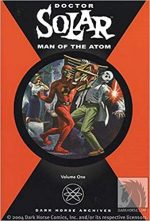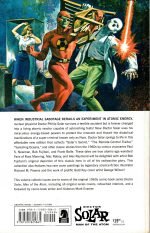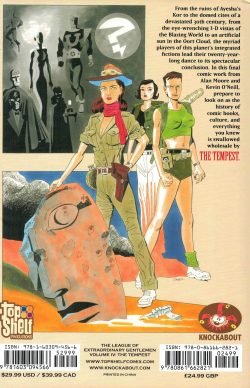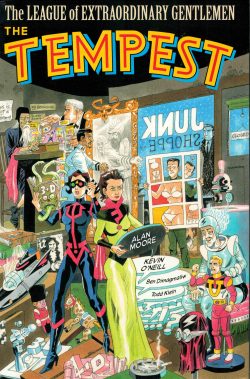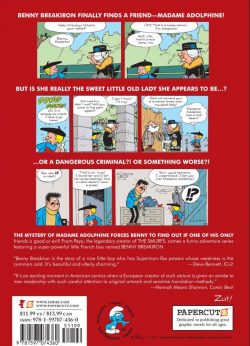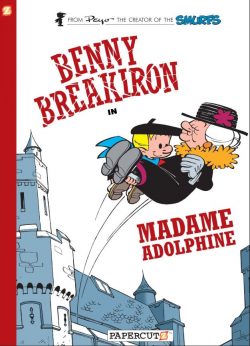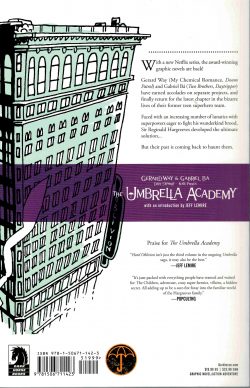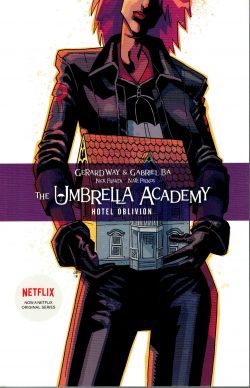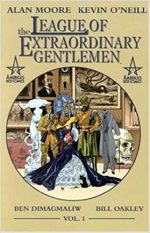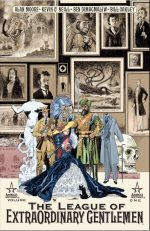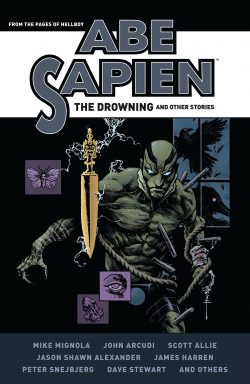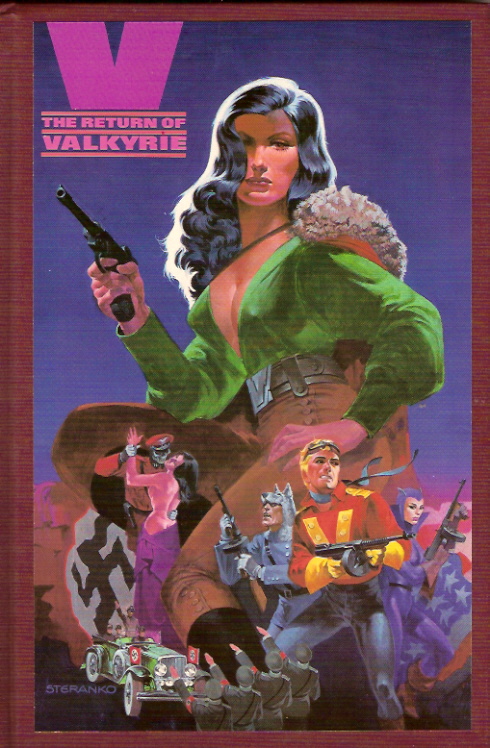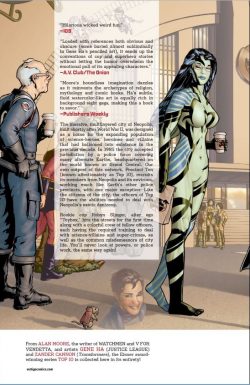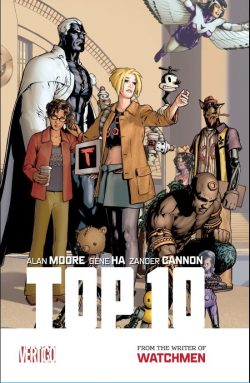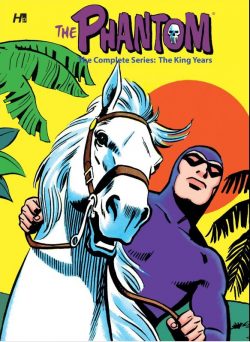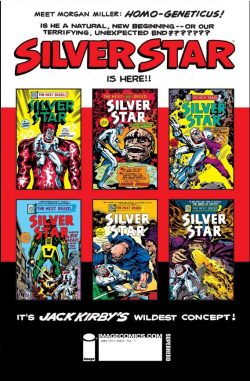
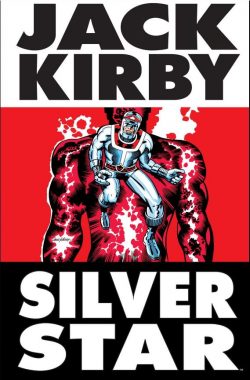
By Jack Kirby, with Mike Royer, D. Bruce Berry, Janice Cohen, Erik Larsen & Eric Stephenson (Image)
ISBN: 978-1-58240-764-7 (HB)
Win’s Christmas Gift Recommendation: Monumental Marvel Magic for Fun Seekers… 8/10
Jack Kirby was – and remains – the most important single influence in the history of American comics. There are millions of words about what the man has done and meant, and you should read those if you are at all interested in our medium.
Of course I’m going to add my own two-bobs’-worth, pointing out what you probably already know: Kirby was a man of vast imagination who translated big concepts into astoundingly potent and accessible symbols for generations of fantasy fans. If you were exposed to Kirby as an impressionable kid you were his for life. To be honest, the same probably applies whatever age you jump aboard the “Kirby Expressâ€â€¦
For those of us who grew up with Jack, his are the images which furnish our interior mindsets. Close your eyes and think “robot†and the first thing that pops up is a Kirby creation. Every fantastic, futuristic city in our heads is crammed with his chunky, towering spires. Because of Jack, we all know what the bodies beneath those stony-head statues on Easter Island look like, we are all viscerally aware that you can never trust great big aliens parading around in their underpants and, most importantly, we know how cavemen dressed and carnosaurs clashed…
Kirby’s creations are magical: they all inspire successive generations of creators to pick up the ball and keep running with it…
In the late 1930s, it took a remarkably short time for Kirby and his creative partner Joe Simon to become the wonder-kid dream-team of the new-born comic book industry. Together they produced a year’s worth of pioneering influential monthly Blue Bolt, rushed out Captain Marvel Adventures (#1) for overstretched Fawcett and, after Martin Goodman appointed Simon editor at Timely Comics, co-created a host of iconic characters such as Red Raven, the original Marvel Boy, Mercury, Hurricane, The Vision, Young Allies and of course million-selling mega-hit Captain America.
When Goodman failed to make good on his financial obligations, Simon & Kirby were snapped up by National/DC, who welcomed them with open arms and a fat chequebook. Bursting with ideas the staid company were never really comfortable with, the pair were initially an uneasy fit, and were given two moribund strips to play with until they found their creative feet: Sandman and Manhunter.
They turned both around virtually overnight and, once established and left to their own devices, switched to the “Kid Gang†genre they had pioneered at Timely. Joe and Jack created wartime sales sensation Boy Commandos and a Homefront iteration dubbed the Newsboy Legion before being called up to serve in the war they had been fighting on comicbook pages since 1940.
Once demobbed, they returned to a very different funnybook business and soon left National to create their own little empire…
Simon & Kirby heralded and ushered in the first American age of mature comics – not just by inventing the Romance genre, but with all manner of challenging modern material about real people in extraordinary situations – before seeing it all disappear again in less than eight years.
Their small stable of magazines – generated for the association of companies known as Prize, Crestwood, Pines, Essenkay and/or Mainline Comics – blossomed and as quickly wilted when the industry abruptly contracted throughout the 1950s.
After years of working for others, Simon & Kirby had finally established their own publishing house, producing comics for a far more sophisticated audience, only to find themselves in a sales downturn and awash in public hysteria generated by an anti-comicbook pogrom.
Hysterical censorship-fever spearheaded by US Senator Estes Kefauver and opportunistic pop psychologist Dr. Frederic Wertham led to witch-hunting Senate hearings. Caving in, publishers adopted a castrating straitjacket of draconian self-regulatory rules. Horror titles produced under the aegis and emblem of the Comics Code Authority were sanitised and anodyne affairs in terms of Shock and Gore, even though the market’s appetite for suspense and the uncanny was still high. Crime comics vanished and mature themes challenging an increasingly stratified and oppressive society were suppressed…
Simon quit the business for advertising, but Jack soldiered on, taking his skills and ideas to a number of safer, if less experimental, companies. As the panic abated, Kirby returned briefly to DC Comics where he worked on mystery tales and Green Arrow (at that time a mere back-up, page-filler in Adventure Comics and World’s Finest Comics) whilst concentrating on his long-dreamed-of newspaper strip Sky Masters of the Space Force.
During that period Kirby also re-packaged an original super-team concept that had been kicking around in his head since he and Joe Simon had closed their innovative, ill-timed ventures. At the end of 1956 Showcase #6 premiered the Challengers of the Unknown…
After three more test issues the “Challs†won their own title with Kirby in command for the first eight issues. Then a legal dispute with Editor Jack Schiff exploded and the King was gone…
He found fresh fields and an equally hungry-for-change new partner in Stan Lee at ailing Atlas Comics (which had once been mighty Timely) and there created a revolution in superhero comics storytelling…
After just over a decade of never-ending innovation and crowd-pleasing wonderment, Kirby felt increasingly stifled. His efforts had transformed the little publisher into industry-pioneer Marvel but now felt trapped in a rut. Thus, he moved back to DC for another burst of sheer imagination and pure invention.
Kirby always understood the fundamentals of pleasing his audience and strived diligently to combat the appalling state of prejudice about the comics medium – especially from industry insiders and professionals who despised the “kiddies’ world†they felt trapped in.
After his controversial, grandiose Fourth World titles were cancelled, Kirby looked for other concepts which would stimulate his own vast creativity yet still appeal to a market growing evermore fickle. His follow-ups included science fiction themed heroes Kamandi and OMAC, supernatural star The Demon, a run of war stories starring The Losers, and even a new Sandman co-created with old Joe Simon, but although the ideas kept coming (Atlas, Kobra, Dingbats of Danger Street), yet again editorial disputes ended up with him leaving for promises of more creative freedom elsewhere…
Jack Kirby’s return to Marvel in 1976 was much hyped at the time but again turned out to be controversial. His new works and creations (2001: A Space Odyssey, The Eternals, Devil Dinosaur, Machine Man) found friends rapidly, but his return to earlier creations Captain America and Black Panther divided the fanbase.
Kirby was never slavishly wedded to tight continuity, and preferred, in many ways, to treat his stints on titles as another “Day Oneâ€: a policy increasing at odds with the close-continuity demanded by a strident faction of the readership…
They were apparently blind to the unfettered, joyous freedom of imagination run wild, the majesty of pulse-pounding thrills and galvanising BIG ART channelling BIG IDEAS!
The end of the 1970s saw Kirby drift into animation: designing characters and scenarios for shows such as Turbo-Teen, Thundarr the Barbarian and even The New Fantastic Four. His comics efforts included graphic novel The Hunger Dogs and Super Powers for DC, and an adaptation of movie The Black Hole for syndicated strip Walt Disney’s Treasury of Classic Tales.
However, his most memorable move was to validate the newly-minted Independent Comics/Direct Sale Market sector where he launched bombastic sci fi shocker Captain Victory and the Galactic Rangers for distributor-turned-publisher Pacific Comics.
For Eclipse, he co-created with Steve Gerber the industry-excoriating symbol of creative rebellion Destroyer Duck (part of a grass-roots campaign that ultimately destroyed the iniquitous work-for-hire business model that had made creators little more than indentured servants for decades).
Also for Pacific at that time, Kirby crafted a 6-issue miniseries returning to his cherished themes of human advancement and perfection. The lure of these projects was that after decades of toil and unleashed genius, now Jack owned his stuff and had complete editorial control…
That’s paid off here in this deluxe hardback and digital edition celebrating the sheer power and exuberance of The King’s gifts. Kirby never threw away a notion or design, and from his copious “Maybe Later/Maybe One Day†file in 1983, he crafted this frantic, frenetic superhero/espionage/doomsday thriller based on an unsuccessful screenplay he and then-assistant Steve Sherman had put together in the 1970s.
Accompanied by an early concept drawing, the origins and impact of the original Silver Star miniseries – which ran from February 1983 to January 1984 – are discussed by Pacific’s editorial director Dave Scroggy in his Introduction before we meet Morgan Miller: Homo Geneticus! in premiere outing ‘Silver Star is here!!’ as, via a communal psychic network, the next stage in human evolution reveals his secrets…
Morgan’s incredible powers come from prenatal genetic tampering by his father Dr. Bradford Miller, who was seeking to offset the repercussions of prospective atomic war, and the son is apparently not the only one of this “Next Breedâ€.
He soon might be though, since earlier prototype Darius Drumm is methodically and ruthlessly exterminating them whenever he tracks them down…
Morgan’s powers manifest when he comes under heavy fire as a good soldier fighting in another American overseas war. After such a public debut, he’s quickly co-opted by Secret Service agent Floyd Custer to protect America, but Drumm’s campaign of terror against ‘The Others’ continues, not just with uncanny powers in the all-too-frail physical world, but also in torment-fuelled sorties into the communal astral plane where Morgan seeks to preserve the life and sanity of mysterious gamin Tracy Coleman…
Sadly, the hero’s success rate is pretty abysmal, and Drumm’s twisted religious mania gives him an advantage in the war, as seen in ‘The Super-Normals: Are they God’s or Satan’s Children?’ It seems the tireless demagogue is also charismatic leader of a vast, anti-happiness and wellbeing cult…
The first four issues were inked & lettered by Mike Royer with colours from Janice Cohen, but the remaining two chapters (which coincided in the 1980s with Pacific moving to more experimental print processes and paper stock, with a noticeable loss of reproduction quality) are graced with the pens and brushes of D. Bruce Berry. They have been re-coloured for this edition by Erik Larsen & Eric Stephenson, who usher in a climactic showdown and moment of global revelation as ‘The World According to Drumm!’ finds hard-pressed hero Silver Star and his surviving species-mates zeroing in on the killer, who has expanded his remit to encompass all Earth, forcing the hero to battle a science-spawned ‘Angel of Death!’
Peppered with concept and developmental sketches, unused artwork and covers, plus pin-ups and designs inked by the likes of Jim Lee and Joe Sinnott, Kirby’s self-described and long-awaited Visual Novel also offers a lavishly illustrated look at his and Steve Sherman’s Silver Star Original Screenplay.
Jack Kirby’s commitment to wholesome adventure, breakneck action and breathless wonderment, combined with his absolute mastery of the comic page and unceasing quest for the Next Big Thrill always makes for a captivating read. His comics should be compulsory for all and found in every home…
© 2007 the Jack Kirby Estate. All rights reserved.

